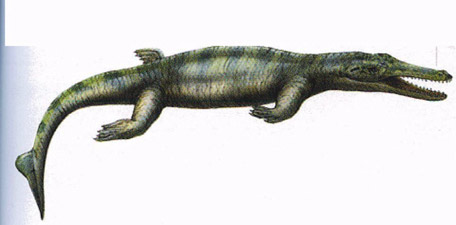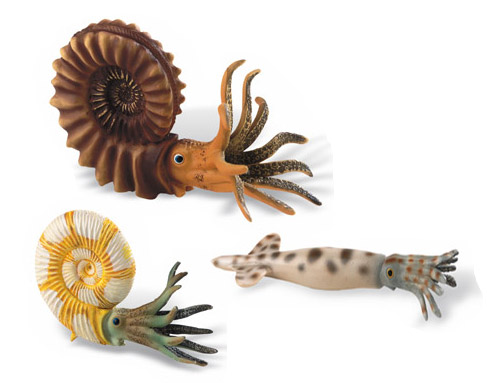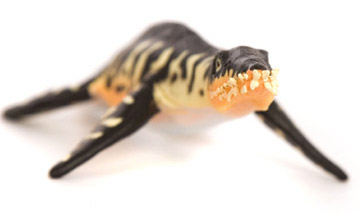Rare Prehistoric Crocodile Fossils Discovered in Switzerland
Switzerland – Famous for Cuckoo Clocks, Army Knives and now Jurassic Crocodiles
The village of Courtedoux in the district of Porrentruy, Switzerland may be hundreds of metres above sea-level today, but rocks dating from the Jurassic show that this area was once part of a shallow, tropical sea full of dangerous marine reptiles such as prehsitorc crocodiles.
For much of the Jurassic period (206 – 144 million years approximately), Europe was covered in warm, shallow seas that teemed with ancient life. Swimming amongst the ammonites, belemnites and ichthyosaurs was a species of marine crocodile, the remains of one such specimen have been found near the village of Courtedoux.
Prehistoric Crocodiles
A team of researchers have announced the discovery of a 150 million-year-old fossil of an ancient crocodile, a genus called Metrioryhnchus, the first time that such a specimen has been found in Switzerland.
The area around Courtedoux is well-known for its dinosaur and other ancient fossils. In fact fossilised trackways of Diplodocus-like footprints have been found nearby, along with a total of nearly 4,000 vertebrate fossils , all dating from the Jurassic period. The foot prints indicate that the geology of this area has strata deposited in terrestrial as well as marine environments. The area has been thoroughly researched over the years but new discoveries are being made all the time, such as this new crocodile.
Fossils of Metriorhynchus have been found in the UK, France and in South America (Metriorhynchus potens).
A distant relative of modern crocodiles this animal had adapted to an almost entirely marine existence, perhaps females only returned to land to lay eggs, like marine turtles. The limbs had evolved into four strong flippers and the tail had broadened and flattened out to provide propulsion through the water.
This marine crocodile grew to lengths of over 3 metres and the many needle-like teeth in the narrow jaws indicate that it was a specialised fish and cephalopod eater. Perhaps it fed on the many different types of ammonite and belemnite that shared its habitat.
An Illustration of Metriorhynchus

Picture credit: Illustrations of Prehistoric Animals of South America
Metriorhynchus
Metriorhynchus is pronounced met-ree-oh-rink-us, the name means “moderate snout”. This particular fossil, found in the Porrentruy district in the west of Switzerland is dated to approximately 150 million years ago, although other fossil finds of this particular genus of marine crocodile have been dated from as early as 165 million years ago (Bathonian faunal stage).
Porrentruy district is in the canton of Jura, the Jurassic period is named after the Jura Mountains that cover much of this region. It was the French chemist Alexandre Brongniart who named the Jurassic.
Scientists believe that this type of marine reptile was an opportunistic feeder, catching ammonites and belemnites as well as being capable of snatching pterosaurs as they swooped low over the sea.
ammonites and belemnites are cephalopods, related to squid and cuttlefish. As a group these type of creatures are extremely important to scientists as ammonite and belemnite fossils can help to identify the relative age of widely separated areas of sedimentary rock.
Fossils of these creatures are very common and particularly diverse, scientists can use the different types of ammonite/belemnite fossil found in layers of rock to work out the sequence in which the sediments were laid down and thus, the relative age of the rock deposits. This process is known as biostratigraphy – using key fossils to date rocks.
A Metriorhynchus Meal – Ammonites and Belemnites
Picture credit: Everything Dinosaur
The picture above shows two ammonites and a belemnite, these nektonic (means they live above the sea floor), cephalopods would have been the stable food of Metriorhynchus and other marine crocodiles.
For dinosaur toys and games, plus prehistoric models including accurate models of ammonites and belemnites visit Everything Dinosaur’s model section on their website: Dinosaur and Prehistoric Animal Models.
Scientists have been able to build up a detailed picture of the ecosystem within these shallow, Jurassic seas that covered much of Europe during this period. As well as marine crocodiles, there were many different types of ichthyosaur and plesiosaur. At the top of the food chain, the top predators were the huge pliosaurs. These animals were marine reptiles, a number of fierce meat-eating genera are known, perhaps the most famous is Liopleurodon. This enormous predator, has been claimed by some sources to be the largest carnivore to have ever existed on the planet.
A number of species of Liopleurodon are known, but whether they really did reach lengths in excess of 25 metres as some scientists and journalists have claimed is still open to debate. With their crown of front teeth, some of which exceeded 18 inches in length they would have been formidable hunters and a 3 metre Metriorhynchus would have been no match for this mighty pliosaur.
Close up of a Liopleurodon (the business end)
Picture credit: Everything Dinosaur
To view the model of Liopleurodon (Liopleurodon ferox) and other marine reptiles in the CollectA Prehistoric Life model series: CollectA Age of Dinosaurs.



